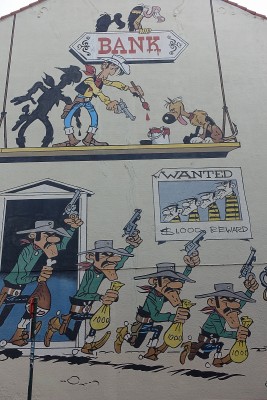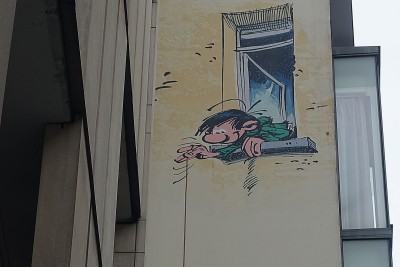Flemish Impressions
(vero;2024-June-15)
These notes relate to Flanders and Brussels only as we shortened our trip and did not visit the Ardennes as we had planned originally. The photos on this page have been taken in the streets of Brussels, they are part of the Comic Strip Trail, a fun way to discover the city.
Driving in Flanders
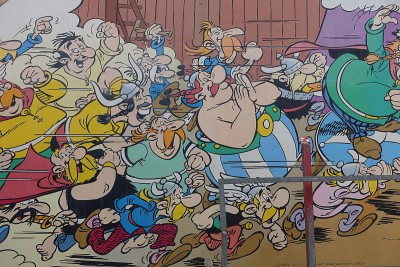 The highways have changed for the better compared to the time we lived in Belgium (1996-97) and we had the luck to escape most traffic jams (which seemed always to be on the opposite lane). But traffic on national and minor roads can be irritating and slow and we could seldom reach an average speed of more than 40 km/h. The invention of the roundabout has not reached Flanders yet: traffic is managed by numerous and lengthy red lights and at (too) many crossroads, a dual carriage-way road often shrinks to one lane, the other one becoming a turning lane, producing endless slowdowns and traffic jams.
The highways have changed for the better compared to the time we lived in Belgium (1996-97) and we had the luck to escape most traffic jams (which seemed always to be on the opposite lane). But traffic on national and minor roads can be irritating and slow and we could seldom reach an average speed of more than 40 km/h. The invention of the roundabout has not reached Flanders yet: traffic is managed by numerous and lengthy red lights and at (too) many crossroads, a dual carriage-way road often shrinks to one lane, the other one becoming a turning lane, producing endless slowdowns and traffic jams.
On the other hand, signalling is top-notch and the diversions extremely well signed, which cannot be said of France or the UK where diversion signs tend to disappear magically after a while and where the drivers are often left to their own devices.
A region infested by heavy goods vehicles
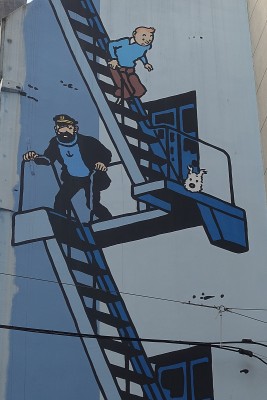 It is not exaggerated, they are everywhere and there are far too many of them on ALL roads. All goods arriving in the ports of Zeebrugge and Antwerp end-up on the road for further transportation. Motorways bring them far away but there is also a lot of local traffic; most cities in the region (even smaller ones like Dendermonde where we were based) are very active economically. They are surrounded by large industrial zones on their outskirts, all served by scores of lorries which end-up clogging the roads.
It is not exaggerated, they are everywhere and there are far too many of them on ALL roads. All goods arriving in the ports of Zeebrugge and Antwerp end-up on the road for further transportation. Motorways bring them far away but there is also a lot of local traffic; most cities in the region (even smaller ones like Dendermonde where we were based) are very active economically. They are surrounded by large industrial zones on their outskirts, all served by scores of lorries which end-up clogging the roads.
A paradise for cyclists
We have been impressed by the number of cyclists and the infrastructure at their disposal. Not only in cities: there is often a lane dedicated to bikes along minor roads between villages (which does not help the fluidity of traffic because these lanes often have their own traffic lights and turning lanes).
Flanders being a flat country, it is maybe no wonder. But still, it is surely not always a pleasant affair when one has to cycle with headwind or on rainy days.
Do you speak Flemish?
Belgium has three official languages: Flemish, French and German and Flanders means Flemish. We were a little surprised by the fact that in a significant number of museums or in public transport everything was often in Flemish only. The main museums offer often a French and English translation but German is almost nonexistent and if a German translation is available, it is succinct and of a very poor quality. Brussels was more multi-lingual, but it is to be expected as it is the capital and seat of many EU organisations with many foreigners around.
That said, we found Flemish people very friendly and those with whom we talked (also simple passers-by) all knew enough French to inform us and talk to us with interest and even more.
Museums
They are well presented (apart from the language problem for some) and are full of treasures, reflecting the wealth of the country. The museums of Fine Arts of Ghent and Antwerp have re-opened after a thorough renovation campaign and have re-organised their collection in a new way: some of the works are no longer exposed by period but by theme (think festivals, work, nature etc).
We found it a bit confusing or annoying and had sometimes difficulties locating works of a certain artist: for example, there are works of Brueghel near ones of Dali, Van Gogh, or painters of the 17th as long as they deal with the same subject.
Some museums have abandoned the concept of the small explanatory panel next to the work of art and there are now touch screens located in a corner not too far away and serving half a dozen surrounding works. This is not bad, as those screens provide much more information than a small simple sign. There were not many visitors when we were there and accessing them was not an issue. But I guess it could become one if there are too many people around, having to queue and wait for them to finish reading before you can have a go at it.
General observations
- The pace of life is slower than in France or England, people are not in a hurry. They are in a better shape than French (not to mention English) people. We hardly saw an obese person.
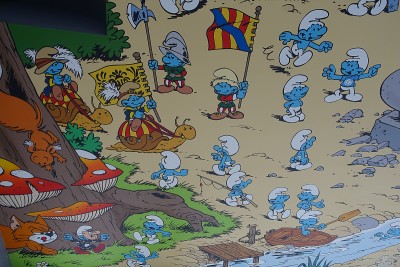 We found people in Flanders elegant, the women often wearing dresses, colourful blouses or tunics, all well accessorised. Men have well-cut clothes, being suits or leisure wear. Brussels was different though: people there are larger and dress in a more "relaxed" way and less elegantly (floating shorts, tracksuits or baggy jeans and t-shirts). But it must be said that we were there on Sunday, this might have been why.
We found people in Flanders elegant, the women often wearing dresses, colourful blouses or tunics, all well accessorised. Men have well-cut clothes, being suits or leisure wear. Brussels was different though: people there are larger and dress in a more "relaxed" way and less elegantly (floating shorts, tracksuits or baggy jeans and t-shirts). But it must be said that we were there on Sunday, this might have been why. - As far as shopping is concerned, Aldi and Lidl are everywhere. Colruyt and Delhaize are two very present Belgian supermarkets in the outskirts of towns and the French Carrefour is often present with smaller shops in city centres.
- The cities we visited were clean despite the lack of waste bins, even in very busy streets. However, we cannot say the same thing of Brussels which we found very dirty in general and neglected as soon as one moves away one inch from the obvious touristy highlights.
- Flemish Belgium has adopted the concept of Unisex toilets in many places which is not to everyone's taste. I personally do not like them: I do not imagine myself checking my appearance (or adjusting my blouse) in front of the mirror with a man next to me washing his hands (not to mention the pee on the toilet seats).
- Everywhere, in every city we visited, the appetising smell of food was prevalent: chips, waffles, moules-frites, chocolate… A feast for the senses.
- Finally, we loved the ubiquitous sound of bells and carillons marking the passing of time.
Conclusion
We had a great time and thanks to a good planning made the most of our trip. With our Belgian Museum Pass we visited museums where we would never have set foot otherwise (industry, music, maritime, trade) and have thus discovered multiple facets of this beautiful region as well as its history and the importance of the sea and its rivers/canals in its development. In all, a very successful and very informative stay.
We hiked for a day along the coast (very long really fine sandy beaches) from Blankenberge to De Haan (and back) and had another day hiking from Dendermonde to the city of Aalst along the canalised river Dender, making it to the confluence of the Dender with the Scheldt on our way back; there were lots of barges on these navigable waterways.
From the cities we have seen, our favourite is Ghent. Bruges is far too touristy (but very interesting), Antwerp a real metropolis. Ghent seemed more authentic and easy to live. We only spent one day in Brussels and it was enough (we know the city well from our time there in the 90s); we gave its Museum of Fine Arts the pass because we had by then an indigestion of Flemish primitives and visited the Centre Belge de la Bande Dessinée instead, which we found quite entertaining.
Want to read more? Go back to Planning Tips or go up to Background
$ updated from: Background.htxt Mon 28 Apr 2025 14:55:38 trvl2 — Copyright © 2025 Vero and Thomas Lauer unless otherwise stated | All rights reserved $




